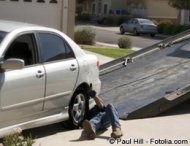We asked three auto insurance experts to break down the standard policy to help you purchase the coverage you need at a price you can afford.
Our auto insurance guide ranks each coverage type by its relative urgency to the consumer by a red, orange or yellow designation. Red is most urgent, and yellow is least urgent. While each is an important tool to cover the legal and financial risks of owning a vehicle, it's unwise to skimp on coverage types in the red zone.
"I encourage people to think about auto insurance not from the premium that's on their renewal notice but from what they're trying to protect, what their need is and what their risk tolerance is in certain areas," says Jim Quade, assistant vice president of Liberty Mutual Insurance in Boston. "Then, imagine having a loss, and think about what you would expect your insurance company to do."
Ready to roll? Let's break down a standard car insurance policy into layman's terms and discover ways to save you money without costing you your coverage.
Liability insurance to protect your assets

Coverage: Liability
Rating: Red
Liability coverage pays for bodily injury and property damage that you, your family or friends cause while driving your car as well as legal and court costs if you're sued in an accident.
Our three experts unanimously place liability in the red zone.
"It's the coverage that is going to protect your assets and earning potential if you're in a bad accident," says Mike Schmisek, a Farmers Insurance agent in Denver. "People can survive financially after totaling their car, but they can't survive a lawsuit after killing somebody."
Skimping on liability coverage in your auto insurance doesn't make sense, according to H.Q. La, a State Farm agent in Portland, Ore. "With lawsuits today, even if you doubled the amount of liability you now carry, the cost is just a fraction of what people think it will be. Typically, you're talking about less than $50 more every six months to double your current liability coverage."
Comprehensive coverage for the unexpected

Coverage: Comprehensive
Rating: Yellow
Comprehensive, or "comp," coverage pays for damage to your vehicle not caused by a collision. Typical covered perils include wind, hail, flood, theft, vandalism, fire and impact with animals. Comprehensive coverage doesn't always include a deductible.
La says your need for comprehensive car insurance may vary, depending on your location, financial circumstances, and the age and value of your vehicle.
"Where there's a deductible built in, you can choose a higher deductible. Comprehensive does not have to do with a person's driving record, and it's relatively a lot cheaper than collision coverage," he says.
Quade agrees. "Because of the (affordable) cost of comprehensive, most people make that the last coverage to drop," he says.
Some companies allow you to carry comprehensive car insurance alone, and others require you to carry comp with your collision coverage.
"If you lease your vehicle, (the lender is) going to require you to have both comp and collision," La says. "They want to protect their interest."
Collision coverage for older cars?

Coverage: Collision
Rating: Yellow
Collision pays to repair damage to your car above a deductible amount when it strikes or is struck by another vehicle or object.
How important is collision?
"It depends on the cost and age of the car, how much it's going to cost to repair it, and whether or not you can afford to fix it by yourself without collision coverage," State Farm's La says.
As your car ages and/or declines in value, you may want to increase your deductible to lower your premium or drop collision altogether from your auto insurance.
"Typically, people will drop collision before they will drop comprehensive on an older vehicle, particularly if their driving record and circumstances causes their average premium to be a little bit higher," Liberty Mutual's Quade says.
"If you lease your vehicle, however, your lender will likely require comprehensive and collision, and may even set the amount of your deductible," he says.
Payments for costly medical attention

Coverage: Medical payments
Rating: Orange
Medical-payments coverage pays for necessary and reasonable medical expenses for you, your family and passengers in your vehicle who are injured in an auto accident, regardless of who caused the wreck. You choose the coverage limits.
"Medical really depends on your situation," says Schmisek of Farmers Insurance. "If you don't have health insurance, I'd move it to the red zone and carry the maximum amount that the company will allow."
Quade says the type of driving you do could affect your need for medical coverage as part of your car insurance.
"If you carpool a lot, it can become important to carry a higher medical-payments deductible to ensure that anyone who is injured in your car, especially children, have the medical attention they need," Quade says. "If you loan the vehicle out to somebody and they're injured, medical payment can kick in for those individuals because insurance follows the vehicle."
Cover the risk of uninsured motorists

Coverage: Uninsured/underinsured motorist
Rating: Red
Uninsured/underinsured motorist coverage, or UM/UIM, primarily pays for bodily injury stemming from an accident caused by a driver who does not have or has insufficient auto liability coverage.
The increased risk of being hit by an uninsured or underinsured driver today has pushed UM/UIM into the red zone in recent years.
"Depending on the state you live in, 30 percent of the people could be driving without insurance due to the economy," La says. "If they hit you and you don't have that coverage, your injuries are not going to be paid for, your passengers' injuries are not going to be paid for, and your car is not going to be covered. Even if you're hit by someone who has insurance, a lot of times they might not have enough insurance to cover the injuries or damages you sustain."
Quade says a good rule of thumb is to match your UM/UIM coverage to the bodily injury limits of your auto insurance liability coverage.
That shouldn't bust your budget. "Uninsured motorist is by far the least expensive of all the coverages," La says. "A lot of times, it's like $1 a month. You won't even notice it."
What if you need road service?

Coverage: Emergency road service
Rating: Light yellow
Car rental coverage pays for the cost of a rental car if yours is not drivable due to a covered loss such as an accident. Emergency road service pays for such conveniences as towing, roadside assistance and locksmith service.
Our experts agree that while these car insurance coverage options might seem like luxuries, they can prove cost-effective for many drivers.
"They're inexpensive coverages that are nice to have, especially if you have an older car where you're more likely to use it," says State Farm's La. "You're talking about less than $1 a month usually, and all it takes is one claim to more than pay for the coverage itself."
Liberty Mutual's Quade offers this tip if you're considering car rental coverage. "Ask what kind of car you'll get with the coverage because oftentimes people are surprised that, when their Chevy Suburban is in the shop, they're left to cart their family of six around in a subcompact."